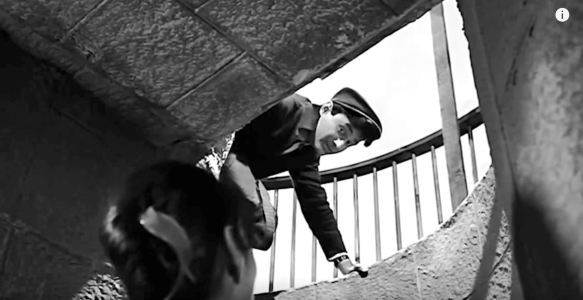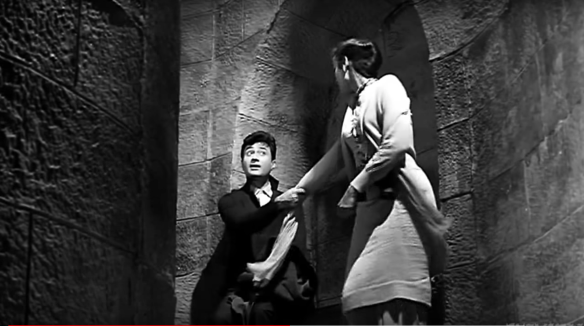
Nutan and Dev Anand co-star in the romantic comedy Tere Ghar Ke Samne (1963).
Today we highlight the lyrics and English translation of “Dil Ka Bhanwar” from the romantic-comedy Tere Ghar Ke Samne (1963).
Dev Anand plays an architect who is inadvertently commissioned to work on a home project for a his parent’ rival family. When he meets and falls in love their extremely pretty daughter, he risks the ire of both families’ elders by pursuing her. A free-spirited, independent woman in her own right, Nutan’s wit matches Dev Anand at every turn. Their repartee scripted by Vijay Anand is reminiscent of the Katherine Hepburn-Spencer Tracey chemistry that audiences universally loved.
S.D. Burman’s soundtrack of Tere Ghar Ke Samne is phenomenal, but few moments in Hindi cinema are more enchanting than the song sequence of “Dil Ka Bhanwar” famously picturised in Delhi’s Qutab Minar. Built in the 12th century by the founder of the Delhi Sultanate, the Qutab Minar is a UNESCO World Heritage Site that attracts hundreds of tourists daily. A narrow tower that ascends five tapering stories, Qutab Minar forces Dev Anand and Nutan into close proximity, each step rippling with amorous opportunity. Unfortunately, because of the bulky film equipment required, a replica set was actually created in order to capture the magic of this site! Each shot emphasizes the intimacy of the space filled by echoes Mohammed Rafi’s lilting melody.
I visited Qutab Minar this winter with my husband and uncle, and was struck by the magnificence of both the tower and the beauty of the surrounding ruins. In any other world, the stone carvings of the Quwwat ul-Islam Mosque within the Qutab Minar complex alone would be the main attraction. I was disappointed to learn that the top of Qutab Minar is no longer open to the public, so my husband narrowly escaped my forcing him to serenade me in broad daylight. Luckily, there was an excellent dosa joint nearby whose buttery goodness made everyone feel that all was right in the world again.

Why, hello there! Dev Anand plays a little peekaboo in “Dil Ka Bhanwar” as he descends the Qutab Minar.
Tere Ghar Ke Samne, like many of Dev Anand’s films, was a vision ahead of its time. Its theme of a never-ended struggle between modernity and tradition hints at irony, as many would look upon his films as being antiquated now themselves. There could be no better place to film such a sequence than in the Qutab complex, where the forward slog of time seems to come to a halt. Donning a stylish newsboy cap and flirting unabashedly in public, Dev Anand’s westernized appeal contrasts with his centuries-old surroundings. He knows better than to continue wooing Nutan as elders dressed in traditional clothing pass them by. As he ceases his serenade, the camera captures a perfect tableau of old and new India.

Dev Anand shields Nutan from the disapproving gaze of fellow-tourists at the Qutab Minar in Tere Ghar Ke Samne (1963).
We hope you love our English translation of “Dil Ka Bhanwar” as much as we enjoyed exploring this delightful song with you!
Dil Ka Bhanwar Lyrics and English Translation:
Dil ka bha.Nwar kare pukaar
The bumblebee of my heart has called out
Pyaar ka raagsuno
Hear its love song
Pyaar ka raag suno re
Oh, hear its love song
Ooh ooh ooh…
Phuul tum gulaab ka kyaa jawaab aap kaa
You are a rose flower, you have no comparison
Jo adaa hai woh bahaar hai
The grace you possess is that of Spring
Aaj dil ki bekalii aa gayii zubaan par
Today the restlessness of my heart has reached my tongue
Baat yeh hai tumse pyaar hai
The words are that I love you
Dil tum hii ko diya re
Oh, I have given my heart to you alone
Pyaar ka raag suno re
Oh, hear my love song
Ooh ooh ooh…
Chahe tum miTaanaa par na tum giraanaa
If you want, make me disappear, but do not make me fall
Aa.Nsuukii tarah nigaah se
Like tears from your eyes
Pyaar kii uu.Nchaaii, ishq ki gehraii
The height of my love, the depth of my love
Puuchh lo hamaarii aah se
Ask my sighs for these answers
Aasmaa.Nchhuu liyaa re
My love has touched the sky
Pyaar ka raag suno re
Oh, hear my love song
Ooh ooh ooh…
Is hasii.N paar pe hum na baiThe.N haar ke
In this beautiful passageway, I will not accept defeat sitting down
Saayaaba.Nkesaath ham chale.N
I will become your shadow and go with you
Aaj mere sang tu, guuNje dil ki aarzuu
Today you are by my side and the desires of my heart echo
Tujhse merii aa.Nkhjab mile
Ever since our eyes met
Jaane kyaa kar diyaa re
I wonder what you have done to me
Pyaar ka raag suno re
Oh, hear my love song
Ooh ooh ooh…
Aap kaa yeh aa.Nchal, pyaar ka yeh baadal
This saari of yours is like a cloud of love
Phir hame.N zamee.N pe le chalaa
It brings me back to earth again
Ab to haaththaamlo, ek nazar ka jaam lo
Now take my hand, allow me one drink from your gaze
Is naye safar ka waastaa
For the of this new journey
Tum mere saaqiiyaa re
You are what makes me feel intoxicated
Pyaar ka raag suno re
Oh, hear my love song
Glossary:
dil: heart; bhanwar: bumblebee; pukarnaa: to call out; pyaar: love; raagaa: melody [in Hindustani classical music, the framework for a composition]; sunnaa: to listen; phuul: flower; gulaab: rose; jawaab: answer, comparison; adaa: grace, style; bahaar: Spring; bekalii: restlessness; zubaan: tongue, language; baat; matter, words; miTaanaa: to make [something] disappear; giraanaa: to make [something] fall; aa.Nsuu: tears; [kisi ki] taraah: as if [something], like [something]; nigaah: eye; uu.Nchaaii: height; ishq: love; gehraaii: depth; puuchhnaa: to ask; aah: sigh; aasmaa.N: sky; chuunaa: to touch; hasii.N: beautiful; paar: passageway, toward; baiThnaa: to sit; haarnaa: to lose; saayaa: shadow; bannaa: to become; saath: together; aaj: today; [kisi ke] sang: by [someone’s] side; guu.Njnaa: to echo; aarzuu: desire; aa.Nkh: eye; jab: when; milnaa: to meet; aa.Nchal: the end of a saari that typically falls over the shoulder; phir: again; zamee.N: earth; haath thaam lenaa: to take [someone’s] hands; jaam: goblet; nayaa: new; safar: journey; waastaa: sake; saaqiiyaa: [literally] the person who serves wine

Dev Anand and Nutan explore the nooks and crannies of Old Delhi’s famous Qutab Minar in Tere Ghar Ke Samne (1963).
Never heard that last stanza before? You’re not alone! Most commercial recordings of “Dil Ka Bhanwar” impiously neglect to include the full version that is present in the actual film. Can you believe your whole life you had missed out on hearing that sweet bliss that is Mohammed Rafi’s “le chalaa-aa-aa-aa“?
– Mrs. 55

Fantastic piece!
Thank you for sharing music with your followers. I always look forward to your emails.
Just thought I would mention that this song is from “Tere Ghar ke Saamne”.
Well written, well sung and well picturaized. Even Lata sang it as part of her Shradhanjali to the late Rafi Saheb.
Thank you. Keep the emails coming.
Shiraz
I love your blog and interest towards hindi songs/movies.
Great post! Your husband must have been quite disappointed too to not have the chance to perform a serenade at Qutab Minar 😦
Truly enchanting!
Excellent selection of the song. Rafi sahab excelled in this song and Burman Da’s enchanting tune with touch of echo and the ambience around all put together made this song eternally lovable.
Excellent post. This song is a gem. Burman the maestro and Rafi the magician. The lyrics are so wonderful too..the bit pooch lo hamari aaha se..is so so romantic. Rafi’s voice just tingles my entire being…what a privilege to hear such music and singing.
In the last stanza, it’s “ek nazar ka jaam *do*”. And I love the way he says “thaam lo” and “saaqiya” in the last stanza. Sounds magical!
What a pleasure to read your stuff! Another one of my favourites commented and translated.
Wrote about it in my modest blog, too (alas, in German): https://hpschriftsteller.wordpress.com/2017/01/26/augen-verdrehen/#more-2320
Thanks for sharing all these words…it’s a great Hindi song…Nutan & Anand are rare findings of Hindi movie culture!
In the third stanza
Is haseen “utaar” par…
referring to their climbing down the Minar